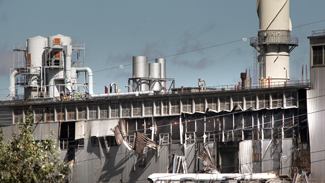BOOM! at Xcel’s Black Dog plant
September 22nd, 2010
An “ignition event” in the coal hopper, more commonly called an explosion and fire… Three firefighters on the scene were injured when it blew after they arrived.
This’ll be old news, but I’ve been incommunicado for a while, lost in the mountains of the Northwest, where there is no cell, no internet… what a concept!
Photo by Bill Klotz, Finance & Commerce (Fair Use!)
An interesting quote:
Here’s some video from KARE 11 with shots of the exterior damage:
In the St. Paul Pioneer Press:
3 firefighters hurt in blast at Xcel Energy coal plant in Burnsville
Workers noticed smoldering coal bin
By Emily Cutts and Deepta Holalkere
Pioneer Press
Updated: 09/21/2010 11:47:43 PM CDTFirefighters put out two relatively small fires at the plant by 2 p.m. Tuesday but remained on site through the afternoon to handle hot spots, Xcel spokesman Tom Hoen said.
Read the rest of this entry »
Xcel, STOP IT!
August 26th, 2010
It’s one of those mornings, had a long bath in the bestest tub in the world, then got the doggies fed and out and pooped, and ready to commence work, fired up the machine, got maybe two emails opened and suddenly… SILENCE and DARKNESS (it’s dark on the side of a bluff). No computer, no light, no ceiling fan… There goes Xcel again, they know I’ve got work to do, and they sent out their terrorist army.
NOT… it was a squirrel. Alan hear the fuse on the distribution pole across the street go, and saw something drop, I said, “it’s a squirrel.” Damned if it wasn’t a squirrel he saw fall, a brave soul who gave is life to Xcel to bring everything to a halt this a.m. Power is back. And neener, neener, neener, neener, Xcel, I got to office in Prestigious West Red Wing withwireless, Greek Strata and unlimited coffee.
Xcel’s “forward sale agreement”
August 5th, 2010
Xcel is trading a bunch of paper for a bunch of money, 21,850,000 pieces of paper to be precise. How much money is that? Seems to be $469,775,000, or $408,500,000, gross, or $396,245,000 net to Xcel, depending on what numbers you look at, or what they sell at!
What will they do with it? According to the prospectus, and an article written about it:
“Xcel Energy intends to use any net proceeds that it receives upon settlement of the forward sale agreement described above, or from the sale of any shares to the underwriters to cover over-allotments, to repay outstanding commercial paper and make capital contributions to its operating subsidiaries.”
Here’s an article from Marketwatch:
Doesn’t this have the feel that they’re desperate for cash flow? We know they can’t get their construction capital to build the Brookings transmission line, and they’re hot to trot both about PUC ordained rate recovery, which they did not get and their Motion for Reconsideration (PUC Docket 09-1048) went nowhere.
Here’s Seeking Alpha’s Xcel 2Q Earnings Call Transcript!
Seeking Alpha Xcel 2Q Earnings Call Question & Answer
And a choice answer snippet from the Q&A:
Xcel’s Hiawatha Project Brief & Transcripts
June 21st, 2010
Xcel Energy, or Northern States Power, whichever, has filed its brief in the Routing docket for the Hiawatha Transmission Project.
Also filed is Notice that the transcripts are now available at local libraries, a big help because the cost is prohibitive, they’re not free here as they are in WI or available via FOIA as they are in New Jersey (called OPRA there):
Which states:
I write to advise that the transcripts for the evidentiary hearings held in the Hiawatha Transmission Project routing proceeding on April 12 – 21 and April 26 – 30, 2010, have been placed in the following libraries: East Lake Library, Hosmer Library, Franklin Library, Central Library, and Roosevelt Library. We have also provided an extra copy to the Central Library with a request that it forward it to the Nokomis Branch once renovations are complete. The transmittal documents are enclosed.
So those of you writing briefs now know where to go!!!!
Terrorist activity and electric infrastructure?
April 24th, 2010
Xcel Energy”s Hiawatha Transmission Project is sticking in my craw again. I’m having one of those “Xcel is evil” kind of days. Xcel is hiding reliability information under a claim of “Security.” How absurd can they get? Don’t they get that if I was going to blow up substations, a) I don’t need their stupid info to do it, and b) I would have done it a long time ago? Earth to Mars, that’s not my M.O. But noooooooooo…
I’ve been looking at Xcel’s SAIDI, SAIFI and CAIDI distribution reliability reports, one of the things I’m happiest about in the 2001 legislative session. Minn. Stat. 216B.029. Why? Because Xcel’s Scott Zima testified at the public hearing for the Hiawatha Transmission Line Project that the claimed “reliability” problems did not show up in their SAIDI, SAIFI and CAIDI reports. WAS ANYONE LISTENING?
What is SAIDI, SAIFI and CAIDI? They’re distribution reliability indices. Here are definitions stolen from Rochester Public Utilities 2009 Electric System Engineering & Operations Report:
- SYSTEM AVERAGE INTERRUPTION DURATION INDEX – SAIDI
SAIDI is defined as the average duration of interruptions for customers served during a specified time period. Although similar to CAIDI, the average number of customers served is used instead of number of customers affected.
The unit of SAIDI is minutes. A common usage of SAIDI is: “If all the customers on the distribution system were without power the same amount of time, they would have been out for _________ minutes”.
- SYSTEM AVERAGE INTERRUPTION FREQUENCY INDEX – SAIFI
SAIFI described the average number of times that a customer’s power is interrupted during a specified time period. “SAIFI-short” is calculated using the number of customers affected by momentary interruptions (such as brief breaker or recloser operations). “SAIFI-long” is calculated using the number of customers affected by sustained interruptions.
The units for SAIFI are “interruptions per customer”. A common usage of SAIFI is: “On the average, customers on the distribution system experienced _______ interruptions”.
- CUSTOMER AVERAGE INTERRUPTION DURATION INDEX – CAIDI
CAIDI is the weighted average length of an interruption for customers affected during a specified time period.
The unit of CAIDI is minutes. A common usage of CAIDI is: “The average customer that experiences an outage on the distribution system is out for ___________ minutes.”
Here’s some background info about SAIDI, SAIFI and CAIDI reports from Edison Institute:
Here’s the Minnesota rule about reporting SAIDI, SAIFI and CAIDI:
7826.0500 RELIABILITY REPORTING REQUIREMENTS.
Xcel has to file these reports annually. And since Xcel’s Mr. Zima’s testimony that the reliability problems they claim as the basis for need for the Hiawatha Project are NOT reflected in the SAIDI, SAIFI and CAIDI reports (WAS ANYONE LISTENING?), I spent some time looking at the annual reports filed this year:
Xcel’s Initial Filing – Docket 10-310
Xcel’s Initial Filing – Docket 10-310 – Attachment D – Part 1
Xcel’s Initial Filing – Docket 10-310 – Attachment D – Part 2
And there’s another older docket where similar information was recently filed:
Xcel’s Annual Filing – 02-2034 – Part 1
To search these dockets,go to www.puc.state.mn.us and click on “Search eDockets” and then plug in the docket numbers.
And here’s an example of what’s wrong with this picture – look at the crudely whited-out Feeder Line column:
Who cares? Well, I do… why? Because when they say that the distribution system is such a problem that they need a big honkin’ shiny new transmission line, and then one of their engineers testifies that this distribution “reliability problem” they’re whining about and inflicting an oversized transmission “solution” on a community about ISN’T showing up in the SAIDI, SAIFI and CAIDI distribution reliability reports, that’s a problem. IS ANYONE TRACKING THIS? It’s not rocket science, it’s basic vetting of their claims!
Looking at their letter in the filing in Docket 02-2034, there’s this amazing statement:
Security Data
The raw reliability data provided with this filing includes “security data” as
defined by Minn. Stat. § 13.37, subd. 1(a). Xcel Energy believes that some of the
raw data on the disks and/or that has been eFiled could be manipulated to reveal
the location and size of certain facilities that have been summarized in the
Monthly Report. The public disclosure or use of this information creates an
unacceptable risk that those who want to disrupt the electrical grid for political
or other reasons may learn which facilities to target to create the greatest
disruption. For this reason, pursuant to Minn. Stat. § 13.37, subd. 2, we have
excised this data from the public version of our filing.p. 5, Xcel’s Annual Filing – 02-2034 – Part I (emphasis added).
Excuuuuuse me?
The public disclosure or use of this information creates an unacceptable risk that those who want to disrupt the electrical grid for political or other reasons may learn which facilities to target to create the greatest disruption.
What a load o’ crap. It is so illogical — those they’re having problems with aren’t necessarily, and probably just AREN’T, the ones to target to create the greatest disruption!
So I calls up Xcel, I do… and leave a message with Bria Shea because Jody Londo who signed the cover letter with the “Security” note was not in, explaining what info in what dockets I’m looking for and that I’m wanting to sign a confidentiality agreement to get it.
But noooooooooooo, guess again. I get a call back from someone in “Legal” (I didn’t know they had an Illegal department) and here they are making a bogus argument about PUBLIC disclosure, and I’m asking for disclosure with a confidentiality agreement. She wants to know if I’m a party, which I’m not, there are no parties in these dockets. And even if a party, even with a confidentiality agreement, no, because it’s a SECURITY issue. Oh, yeah… right… I’m a terrorist, wanting their “feeder line” information to take out electricity to some select target… Guess she’s been talking to Mike Krikava, thinking only a terrorist would want to enter a 2005-MAPP map into a transmission proceeding. That’s as wacky as a judge thinking it’s appropriate to do a transmission proceeding without a map entered in as evidence!
So now I get to “evaluate my options.” It’s possible to do some triangulation with the reports and with the Attachments to Xcel’s Hiawatha Project Application, but… sigh… we all know what their concern is — that someone might read it and make some sense of it, and understand what it means.







